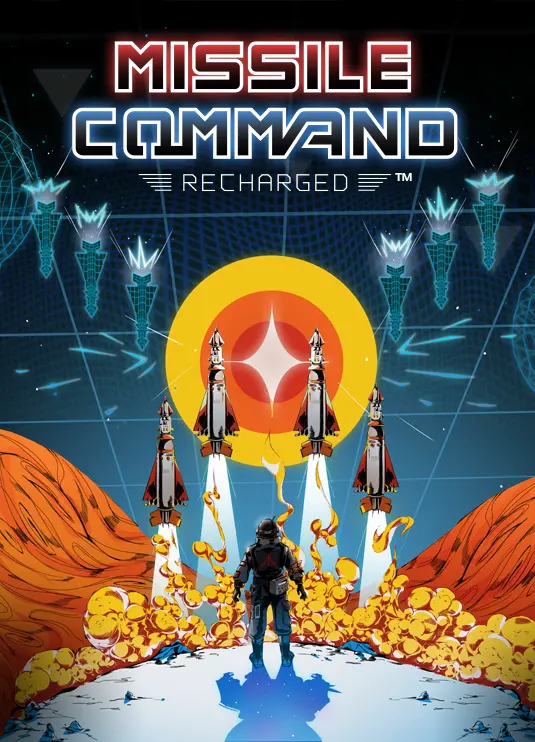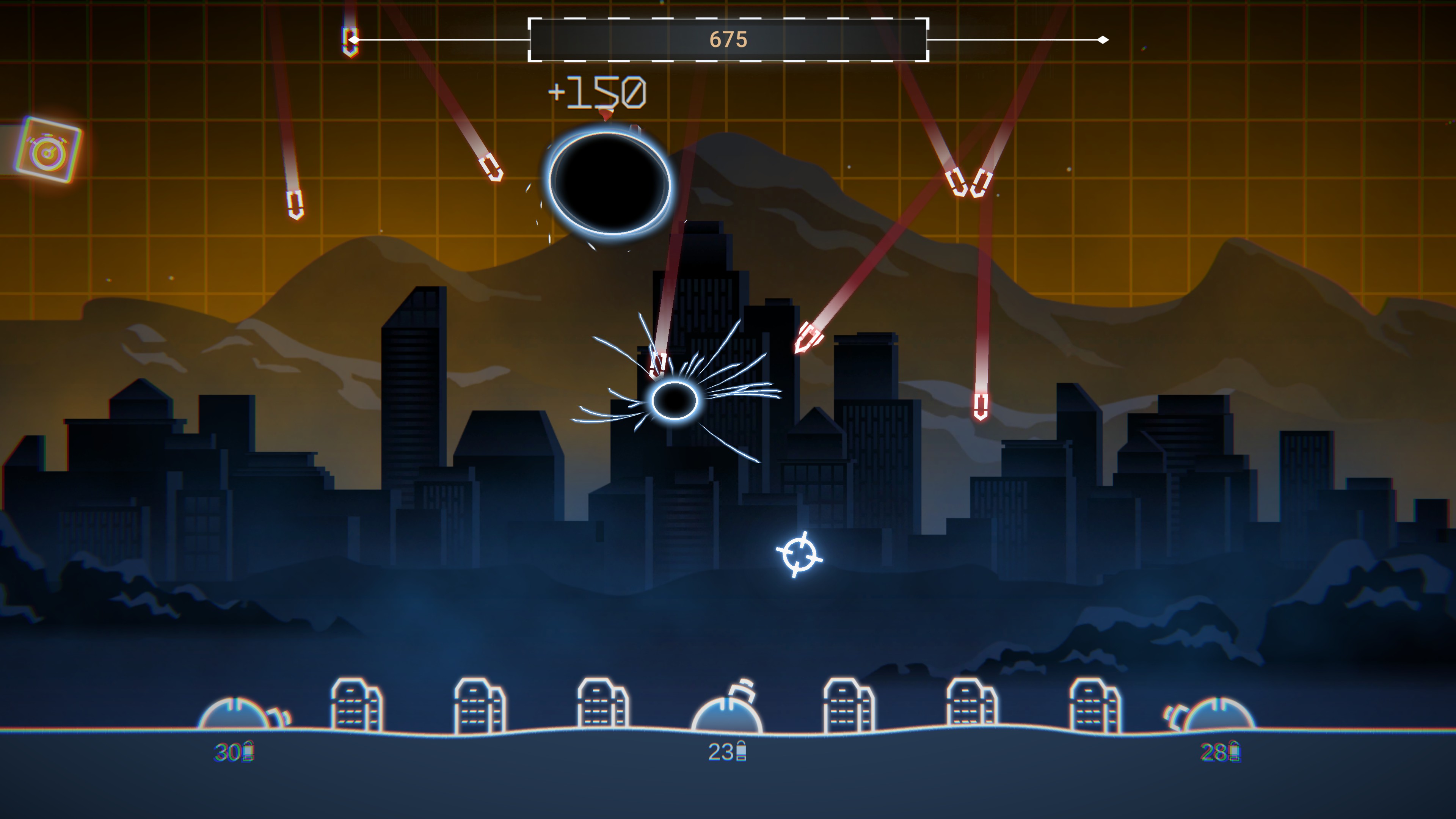Search
[{{{type}}}] {{{reason}}}
{{/data.error.root_cause}}{{{_source.title}}} {{#_source.showPrice}} {{{_source.displayPrice}}} {{/_source.showPrice}}
{{#_source.showLink}} {{/_source.showLink}} {{#_source.showDate}}{{{_source.displayDate}}}
{{/_source.showDate}}{{{_source.description}}}
{{#_source.additionalInfo}}{{#_source.additionalFields}} {{#title}} {{{label}}}: {{{title}}} {{/title}} {{/_source.additionalFields}}
{{/_source.additionalInfo}}- Details
- Category: Computer
- By Jason Gress
- Hits: 2103
Missile Command: Recharged (PC)

Missile Command: Recharged
Developed By: Adamvision Studios, Sneakybox
Published By: Atari
Release Date: November 1, 2022
Available On: Atari VCS, Linux, macOS, PlayStation 4/5, Switch, Windows, Xbox One/Series; Android and iOS have the older 2020 version
ESRB Rating: E for Everyone
Genre: Arcade
Mode: One or Two Player
MSRP: $9.99
Thank you Atari for sending us this game to review!
Note: This review is of the 2022 release of Missile Command: Recharged. The 2020 release was recently removed from sale for non-mobile platforms and is different from this improved version.
Oh, Missile Command. I'm not sure if this was one of the first five, ten, or twenty games I've ever played in my life, but it's definitely one of the earliest. We had this game on the Atari 2600 (few families dropped the kind of cash needed for an Arcade in their home), but I remember it being a fun, challenging, and surprisingly intelligent game that took complete focus to do well in. The 2600 version is also a remarkably faithful reproduction, even if it had to have only one turret (rather than three). It's also an incredibly simple game - yet also extremely important in the history of video games, as my daughter pointed out while playing it with me, it's arguably the very first Tower Defense game.
For those not familiar with the 1980 classic, Missile Command has a very simple premise: you are the commander in charge of controlling three (in the Arcade version) or one (in the early home versions) anti-missile batteries, and you must shoot them into the air to preemptively explode the oncoming missiles before they destroy your cities. That's pretty much it - that's Missile Command.
The game takes place on a simple 2D plane, where the top of the screen is the sky, and the bottom has icons that represent each of the cities you are trying to defend. Your turrets, three in the original Arcade (and also in Recharged) are also along the bottom of the screen, on the left, center, and right sides. Missiles then come raining down from the top of the screen, descending down towards the bottom; anything the blast hits dies, including cities or turrets. When you shoot up at the oncoming missiles, you cause explosions, which expand into a fairly large circular blast. Any missiles that touch the blast radius also explode. Managing what you can explode, often timing for two or more at once, is a large part of the strategy behind Missile Command.
It's also a game of attrition; the longer you last, the higher your score. In the original Arcade, as well as the 2600 version, you have a limited amount of ammunition that you need to use to clear the level of a finite number of missiles coming to attack you. You then progress to the next one, and missiles keep coming faster and faster, along with other ships and such that can also drop attacks on you. As the game gets more difficult level by level, the attacks come more quickly and aggressively, requiring more careful tactics and ammunition management.
Now that you have a good foundation for the original classic game, I can then explain how this Recharged version is similar and different.
Strong Points: Entertaining action gameplay based on an Arcade classic; fun for short game sessions; local two-player mode; very challenging; great music; graphics look great for the art style; works on Steam Deck
Weak Points: Better in short spurts than long gameplay sessions; no Steam Cloud support; Steam Deck works, but touchscreen has bugs; second player stuck with a gamepad, which is a significant disadvantage
Moral Warnings: Lots of missiles trying to bomb your cities, and you will almost certainly lose eventually
Missile Command: Recharged was actually the first Recharged title back in 2020, and was released for the low price of $2.99. It was a feeler product intended to see if there was a market for these Recharged remakes; there was, so there have been several. But it was quite basic, had very simple geometric shapes for most things like city buildings and turrets, and even enemy ships and upgrades looked simple. It also lacked many of the features included in Recharged titles since, like Missions. Atari and Adamvision decided that the game needed more to meet their standards, but felt that a paid upgrade would be necessary to make it worthwhile. Rather than opting for DLC or some other approach, they chose to delist the old game and republish this new and vastly improved version for the new price of $9.99 in its place. Any owners of the original received $3 off, so that initial investment was not lost.
While I have not played the 2020 release on any PC or console, I did take a peek at the free to play mobile version. If the PC/console versions are anything like that one, you aren't missing much. This new release is better than that one in every way imaginable. The art is more distinct and looks better, there is more to do, and the music is great (the original's music was good, too).
The two main modes of play are Arcade and Mission. Ironically enough, the Mission mode is more like the classic Arcade game, and the Arcade mode resembles the 2020 Recharged release the most closely. I wish there was there was a mode that even more closely resembles the Arcade classic, but what's there now is certainly still enjoyable.
Arcade mode is the simplest, but also departs from the classic the most. In this mode, your turrets have unlimited ammunition, so spamming the sky with explosions is most definitely a viable strategy. When you start a game, you are offered to apply up to three modifiers to that session, with corresponding score modifiers also. Your score is not only important because it's uploaded to the leaderboards, but you can spend earned points on upgrades which makes the Arcade mode a bit easier (though not too much). There are four type of upgrades: Power, Rebuild, Reload, and Speed. Power and Speed affect your shots, with a faster-moving missile, or a larger explosion; Rebuild and Reload affect how quickly your cities and turrets respawn.
The modifiers also make for quite a different game. The No Rebuilding modifier (with a +2.5% score modifier) means that once something is gone, it's gone. The Hyper modifier (with its +2.5% score modifier) makes the game quite frantic and fun; I usually play with this, assuming I am playing with a mouse. I would not recommend this for controller players. The Calm modifier (-50% score modifier) slows the game down significantly and might also be a good choice for controller users, though the score penalty is steep.
The high score system is of course a classic motivator to keep playing, but I found it didn't take too long to max out on the upgrades; no more than a couple of hours tops. The cool thing is seeing my Steam handle on the high score table; as of this writing, I'm #19! (I doubt it will last.)
The Mission mode is very similar to other Recharged titles where you have (in this case) 32 Missions to complete. In these Missions, you have a limited amount of ammunition and a pre-programmed set of opponents. Your job is to survive with at least one city still standing; your score depends on how well you do. This definitely feels a lot more like the classic Missile Command, because resource management has always been an important part of that game, and it is here too. These Missions are tough. As the level progresses, more and more missiles fall on your head, so quick thinking and efficient use of shots and powerups is a must. In most Recharged titles, the skills you learn in Missions directly helps in Arcade. That is less so here; obviously aiming strategies carry over, but while spamming bombs is a perfectly viable strategy in Arcade, it's actually quite detrimental to Missions.

Higher is better
(10/10 is perfect)
Game Score - 86%
Gameplay - 16/20
Graphics - 9/10
Sound - 9/10
Stability - 4/5
Controls - 5/5
Morality Score - 98%
Violence - 9/10
Language - 10/10
Sexual Content - 10/10
Occult/Supernatural - 10/10
Cultural/Moral/Ethical - 10/10
Both Arcade and Mission modes have a local two-player option. In Arcade, there is no downside; you get two targeting reticles and two brains to aim them. Nice! In Mission mode, you are limited in ammunition just as you are in single, so a low-skilled second player can hold you back if they miss a lot or are inefficient with their shots. It's also worth noting that only one player (player one) can use the mouse, and using the mouse is a HUGE advantage.
The original Arcade title used a trackball, and that analog point-anywhere control is critical for high-level play. Of course a computer mouse (or a computer trackball - they exist too!) are near-perfect analogs for the Arcade controls. Unfortunately, to this day, modern operating systems do not allow for more than one connected mouse to be separate inputs (without special software, at least), so until that day comes, we can't have two mouse/trackball games. I hope that day comes sooner or later! Gamepad control works fine, but it just isn't the same, especially as things get frantic.
I can't believe I got this far with only barely mentioning powerups. While defending your cities, sometimes a powerup icon can fly across the screen. If you can spare a shot, it's often worth hitting it, as it can do all kinds of things to you, like give you larger blasts, shields to protect your cities and turrets, slow down time, and more. It's a really useful game mechanic that is a lot of fun, also. This is common to all games modes; Arcade and Mission.
It ran great on every computer I ran it on, including Steam Deck, with the caveat that touchscreen input is wonky in Linux (which the Steam Deck runs). Otherwise, it runs great. Because of the mouse input option, I recommend the PC version over most of the consoles (unless they support mouse input with this game; some might). There was also one time that it seemed to stutter, but that could have just been my computer acting up; it didn't come back after a reboot.
From a moral point of view, it's pretty clean. Missiles go up, and missiles go down. Technically there are probably people in those cities, and they do blow up, but there's nothing to see; it's all abstracted. You're probably going to lose eventually, and people theoretically die; nothing is shown but explosions. My four-year-old self played the original Missile Command and I don't see why a younger player wouldn't enjoy this game too without issues.
Missile Command: Recharged is a solid re-imaging of the classic title whose name it bears. Missile Command was a great game back in 1980, and this remake is a lot of fun now, too. I will say that I had more fun with small play sessions rather than large ones; it's a simple game at heart, and it can get a bit repetitive in longer stretches. It doesn't help that it's extremely difficult as time goes on, and barely gives you a breather (on Arcade mode). While it's not my favorite of the Recharged titles so far, I definitely enjoy playing it, and I think you will to. Recommended.




